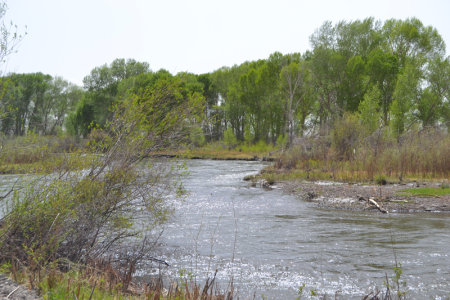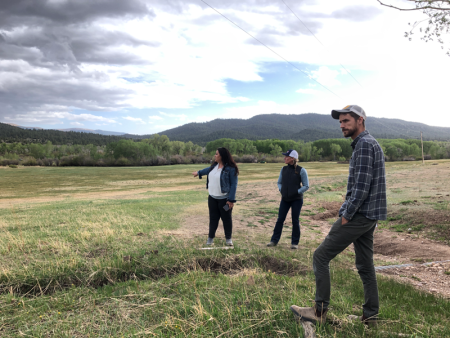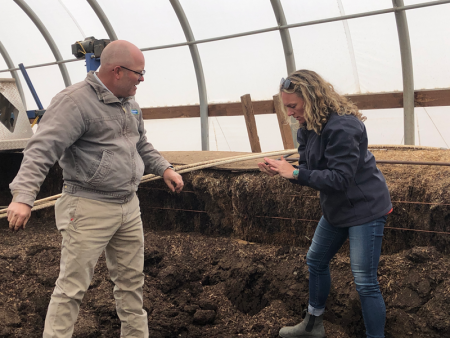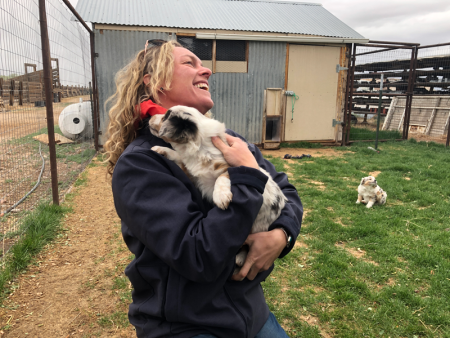Water was an important focus of our trip as it is a critical resource for agriculture. Part of the purpose of our visit to the San Luis Valley was to see irrigation projects and attend the Congreso de Acequias, an annual celebration of water, land, and community that shines a light on acequias as both irrigation ditches and forms of community self-governance. Throughout our visit, we were reminded that water plays an essential role in the communities of the Valley.
Agricultural communities have a deep relationship with the land they tend and the water which allows them to grow crops. This was evident not just on our water-related stops, but throughout our time in the Valley. We heard from the producers and farmers we met about their give-and-take relationship with water: lately it’s been a lot of take, and not a whole lot of give.
The megadrought that has impacted the western United States has been no stranger in this high alpine valley - a “snow bird” that normally shows high on the peak just outside the town of San Luis and has long been used as an indicator for snowpack was almost gone by mid-May.
When we met with local community leaders in La Jara, we were privileged to sit down with groundwater subdistrict members and water conservancy district managers to discuss recent developments with groundwater sustainability. Senator Cleave Simpson walked us through much of the ins and outs with past history and potential future options. We learned a lot more about the specifics of each district’s unique position and heard from the farmers who will be impacted by the upcoming funding from SB 22-28.
The bill was signed in Alamosa just a few days later and will split $60M in funding between the Rio Grande and Republican River basins to help with compact compliance and to restore the health of the aquifers of both rivers. Some options will include buying back and retiring irrigated acreage and through other tactics determined by the Colorado Water Conservation Board in collaboration with water conservation districts in each basin.
Another of our tour stops was just outside of Manassa, at a ditch project currently underway with the guidance of the Rio Grande Headwaters Restoration Project (RGHRP). The Elledges Ditch is part of a five ditch development project which received grant funding from CDA’s Drought Resilience program. The project aims to increase water efficiency and flow through updated headgates, bank stabilization, and removal of sediment build up along all five ditches.
Emma Reesor, Executive Director of the RGHRP, has worked diligently with ditch owners and the Conejos Water Conservancy District to restore resiliency into these particular stream reaches. It’s a little strange to call a diversion structure “beautiful,” but that’s what it is when you see it accomplishing both agricultural irrigation and environmental benefits for fish and wildlife.
The San Luis portion of the tour intersected both history and the future, with visits to the last working common grazing area in the world (since Boston Commons no longer serves local livestock) and two Costilla County farms, providing for the future of agriculture in the south of the San Luis Valley.
The two family farms are operated by Costilla County Commissioner Steven Romero and Costilla County Conservation District director Ronda Loboto. Both Steven and Ronda explained the deep connection their families have to the land and the water that irrigates it, while noting that the future in agriculture in their area is also uncertain. Seeing firsthand the obstacles these southern Colorado farmers are facing -- rising costs of inputs and labor, less water to irrigate their fields, and uncertain weather patterns -- as well as their ingenuity in overcoming them, focused our conversation on how CDA can support the people who make their living by working the land and feeding our state.
The topic of land and water stewardship was also one that came up at nearly all tour stops. From integrating soil health practices and energy efficiency technology to optimizing water usage and improving infrastructure, farmers across the Valley are already responding to the climate crisis.
One of the more surprising stops on the tour was in Jaroso, where we saw Dave West’s static fungal compost pile in all its earthworm action.
With a 3 lb/acre application and teeming with life, the concentrated organic matter is helping build healthy soil, which in turn builds resilience, releases nutrients, holds water, and potentially reduces costs and increases productivity. Mosca-Hooper Conservation District is at the forefront of this work in Colorado - which is part of the “Johnson-Su method” out of Las Cruces, NM. This might have been one of the best parts of the trip, as homemade sourdough cinnamon rolls and mini Aussie puppies were also on site.
We wrapped up our tour with members of the Sangre de Cristo Acequia Association and other community members during the annual Congreso de Acequias.
Acequias are both irrigation ditches and forms of community self-governance. These cultural anchors have been tended to for centuries by Spanish and Mexican farmers who have been farming these lands since long before Colorado became a state. Congreso is a time to reinforce the strength of the acequia communities, and remind people of how important practices like the limpia de la acequia are to continuing tradition.
Obviously, this trip was packed with incredible conversations with dynamic and amazing people. No matter where we went, we noticed the determination, kindness, and deep conviction of the Valley’s communities.
We are grateful for the short time spent learning from and with them, for as the K-5 students reminded us at Congreso through their Querencia posters, “If you take care of the land and water, it takes care of you.”







